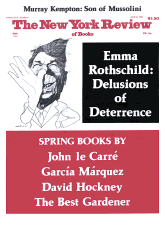In response to:
How Should a Gent Behave? from the February 3, 1983 issue
To the Editors:
Noel Annan (in “How Should A Gent Behave,” NYR, February 3) has forgotten his Trollope if he thinks that Lady Eustace and Lord Fawn’s was a marriage of convenience that worked. They never married. And their courtship was fraught with disagreement over the diamonds; Lord Fawn, while striving above all else to be a perfect gentleman, desired to break his engagement when Lizzie Eustace and her necklace became infamous. Surely Lizzie’s first marriage to Lord Eustace wasn’t successful since her insincerity drove him to an early grave. In fact, the only successful marriage of convenience that comes immediately to mind is Lady Glencora M’Cluskie’s to Plantagenet Palliser—at least I suppose one would say it worked, despite the great dissimilarities in their personalities. Or perhaps Archbishop Grantly’s daughter, Griselda, was successful in her marriage to the Lord Dumbello. It was certainly considered a great social triumph, but, if they were happy, Trollope doesn’t let on. And then, there was the incident between Griselda and Plantagenet involving their mute flirtation.
In fact, I believe that Trollope preferred love matches. A few of these include, of course, Lord Chiltern’s with Violet Effingham, Dr. Thorne and his unconventional bride, Madame Max with Phineas Finn, and Eleanor Bold (née Harding) to Dean Arabin. Regardless of how a gentleman should behave, some of Trollope’s favorite gentlemen married for love.
Betsy Nicoletti
Chester, Vermont
Noel Annan replies:
Of course Betsy Nicoletti is right. I did not spot the howler until I got my copy of The New York Review and knew someone else would. But I did not think I implied that Trollope preferred marriages of convenience. On the contrary I agreed with Shirley Letwin that he made no bones about his ladies as well as his gentlemen being sexually aroused and marrying for love.
This Issue
April 14, 1983



